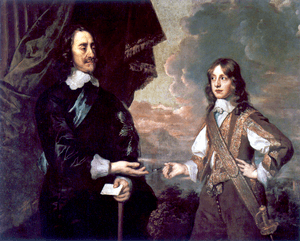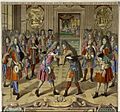James II facts for kids
James II (born in 1633, died in 1701) was the King of England and Ireland, and also King of Scotland, where he was known as James VII. He was the last Roman Catholic monarch of England, Scotland, and Ireland. His time as king was quite short, lasting from 1685 to 1688. He was removed from power during an event called the Glorious Revolution.
Contents
King James II
James was born in London, England, to King Charles I and Queen Henrietta Maria. He was the second surviving son of his parents. His early life was full of big changes and challenges because of the English Civil War.
Early Life and Family
James grew up during a very difficult time in England. His father, King Charles I, was involved in a civil war against Parliament. This war led to his father's execution in 1649. After this, England became a republic, and James had to leave the country.
A Prince in Exile
James spent many years living in other European countries, especially France. While in exile, he served in the French and Spanish armies. He learned a lot about military strategies and leadership during this time. He was a brave soldier and gained valuable experience.
James married Anne Hyde in 1660. They had several children, but only two daughters, Mary and Anne, survived to adulthood. Both of them later became queens of England. After Anne Hyde passed away, James married Mary of Modena, an Italian princess. They had a son, James Francis Edward Stuart, who was born in 1688.
Becoming King
After his brother, King Charles II, died in 1685, James became king. He was crowned King James II of England and Ireland, and King James VII of Scotland. People hoped he would rule fairly and keep the country peaceful.
His Time as King
As king, James II wanted to make changes that would give more rights to Roman Catholics. At the time, England was mostly Protestant, and there were laws that limited what Catholics could do. James believed in religious freedom for everyone, but many people worried that he was trying to bring back Catholicism as the main religion.
Challenges and Changes
James tried to remove laws that discriminated against Catholics and other non-Protestants. He also appointed Catholics to important positions in the government and army. This made many Protestants, especially members of Parliament, very uneasy. They feared he was becoming too powerful and might try to rule without Parliament.
The Glorious Revolution
The birth of James's son, James Francis Edward, in 1688 was a turning point. Before this, many Protestants hoped that James's Protestant daughter, Mary, would become queen. But with a Catholic son, it seemed like a line of Catholic kings might follow. This fear led to a group of important English leaders inviting William of Orange, who was James's nephew and son-in-law (married to Mary), to come to England.
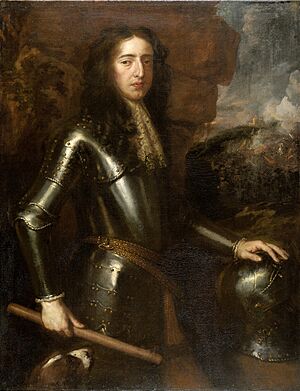
William arrived with an army, and James's support quickly disappeared. Many of his own soldiers and even some of his family members joined William. James decided to leave England, and this event is known as the Glorious Revolution. It was "glorious" because it happened with very little bloodshed. William and Mary then became joint rulers of England.
Later Life and Legacy
After leaving England, James II went to France, where he was welcomed by King Louis XIV. He tried to regain his throne, especially by leading an army in Ireland. However, he was defeated by William of Orange at the Battle of the Boyne in 1690.
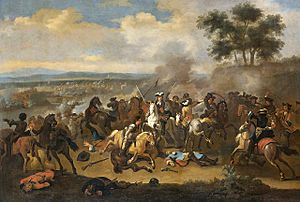
James spent the rest of his life in exile in France, living at the Château de Saint-Germain-en-Laye. He died in 1701. His son, James Francis Edward, later tried to claim the throne, but he was unsuccessful. James II's reign is an important part of British history because it led to big changes in how the country was governed, making Parliament more powerful and ensuring a Protestant line of succession.
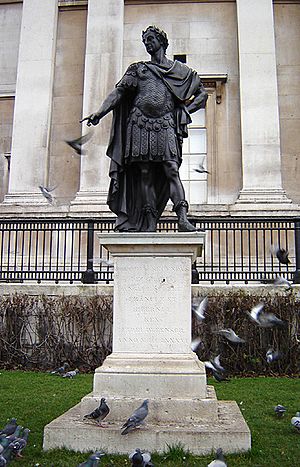
Images for kids
-
Henri de La Tour d'Auvergne, Viscount of Turenne, James's commander in France
-
James and Anne Hyde in the 1660s, by Sir Peter Lely
-
Wedding suit of James II, 1673, in the Victoria and Albert Museum
-
The Duke of Monmouth was involved in plots against James.
-
Laurence Hyde, 1st Earl of Rochester, once a supporter of James, turned against him by 1688.
-
Louis XIV greeting the exiled James II in 1689
-
The Château de Saint-Germain-en-Laye, James's home during his final exile
-
Tomb of James II in the parish church of Saint-Germain-en-Laye, commissioned in 1828 by George IV when the church was rebuilt.
-
James's son was known as "James III and VIII" to his supporters, and "The Old Pretender" to his enemies.
-
Half crown coin of James II, 1686
See also
 In Spanish: Jacobo II para niños
In Spanish: Jacobo II para niños


